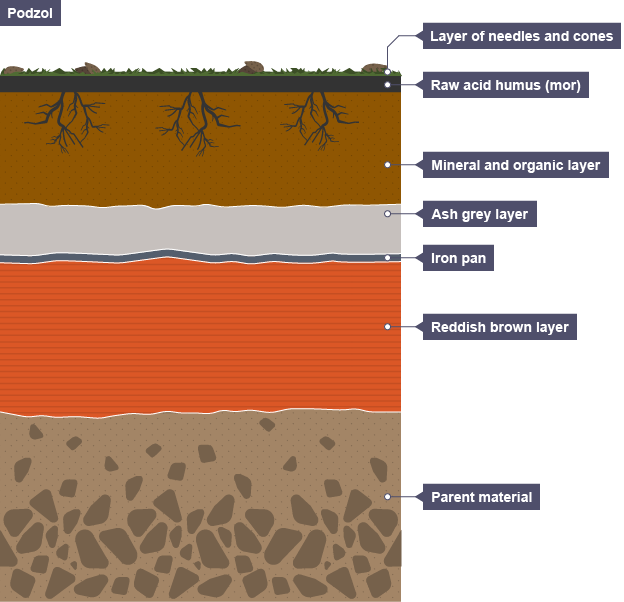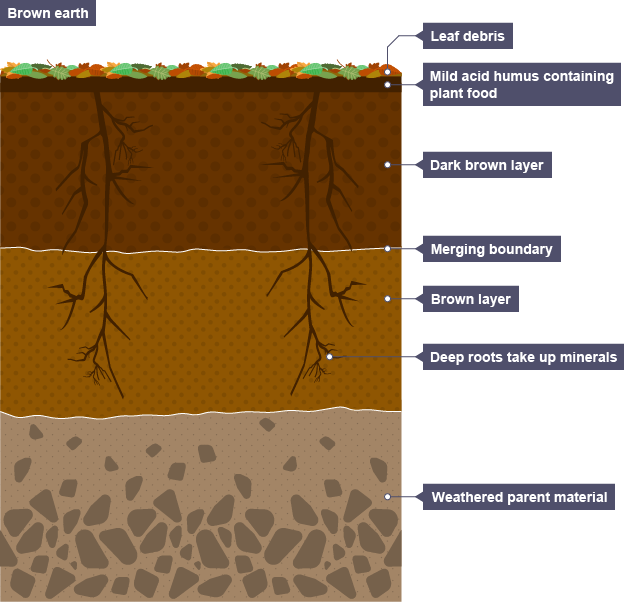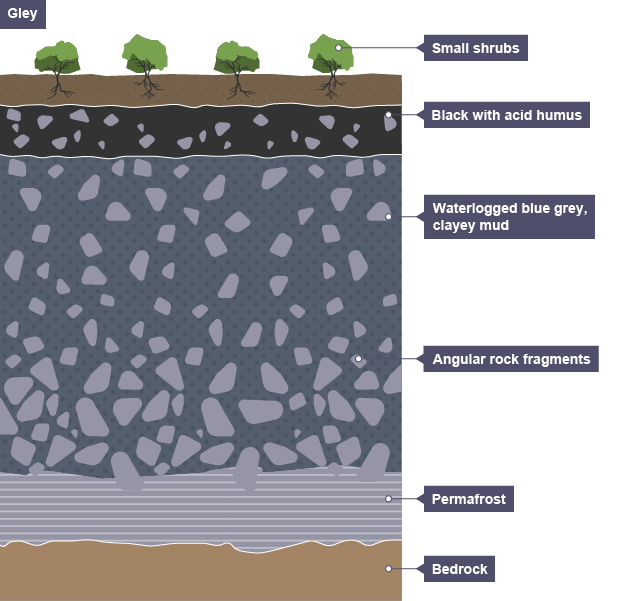Biosphere
1/45
Earn XP
Description and Tags
Name | Mastery | Learn | Test | Matching | Spaced |
|---|
No study sessions yet.
46 Terms
What are the six factors in soil formation
Biota/organisms
Climate
Drainage
Parent material
Relief
Vegetation
Parent material
This refers to the underlying rock or sediment which gets broken down due to biological or chemical weathering
Relief
This refers to the height and shape of the land
Drainage
Whether water can or cannot move through the soil easily will affect the development of the soil profile
Climate
This refers to the precipitation and temperature, which can effect the distribution of organisms, vegetation, and the rates of decomposition
Podzol profile

Brown earth profile

Gley profile

State the three main soils in Britian
Podzol, brown earth and gley
Eluviation (E horizon)
Horizons that loose materials, light in colour and has a sandy texture
Illuviation (I horizon)
Horizons that gain materials, dark in colour and has a dense texture
Formation of podzol
Biota/organisms: few organisms, leading to the formation of distinct horizons
Climate: northern altitudes have low temperatures which decreases the rate of decomposition, resulting in a thick, black, acidic mor humus
Drainage: northern altitudes have high precipitation which leads to leaching, creating an iron pan between the A/B horizons which impedes drainage and causes waterlogging
Parent material: weathered glacial rock
Relief: steep sleeps, encouraging leaching
Vegetation: coniferous vegetation has shallow roots which limits the recycling of any nutrients and any absorption of leached minerals
Formation of brown Earth
Biota/organisms: soil organisms aerate and mix the soil, leading to the formation of indistinct horizons
Climate: south-facing slopes have higher temperatures which increases the rate of decomposition, resulting in a thick, mildly acidic mull humus layer
Drainage: the long tree roots penetrate the soil which absorbs nutrients
Parent material: biologically weathered rock
Relief: gentle slopes, leading to lower rates of erosion
Vegetation: deciduous vegetation produces a deep leaf litter
Formation of gley
Biota/organisms: few organisms due to anaerobic conditions, leading to the formation of distinct horizons
Climate: low temperatures and high precipitation leads to slow decomposition, creating a thick, black, acidic mor humus layer
Drainage: impermeable rock impedes drainage and causes waterlogging
Parent material: thick impermeable rock
Relief: flat surfaces such as plateaus or at the foot of a slope, meaning that water cannot drain away
Vegetation: shrubs have shallow roots which limits the recycling of any nutrients
Leeching
When materials and humus move downwards, occurs when precipitation exceeds evaporation
Soil
Soil is the thin layer of loose material which covers most of the Earth’s land surface
Biota/organisms
This refers to the large and small living things which cause a soil to develop, including vegetation. They help the soil develop by breaking down the organic and inorganic matter
Cold climates
Soils will take longer to form as organic decomposition will be slower
Warm climates
Organic material decomposes faster and encourages soil organisms to aerate and mix the soil
Wet climates
This encourages leeching of the soil
Steep slopes
This leads to a faster run-off of water and greater erosion rates which leaves the soil thin and and infertile
Flat slopes
This leads to more leeching and waterlogging. However, this can accumulate soil washed down slopes
Waterlogging
Saturated soil filled with water that creates an anaerobic environment unable to support organisms
Why are organisms important for the formation of soils?
Concentrate nutrients at the surface of the soil
Helps aerate and mix the soil
Leaves behind deposits that adds nutrients to the soil
Vegetation reduces erosion by binding the roots to the soil
Decomposition by organisms
The breaking down of organic material into smaller parts, especially by the action of decomposers
Leaf litter by organisms
Decomposed dead organic material that creates an organic rich layer called humus on the A0 horizon
Coniferous vegetation
Found in cold climates, this vegetation has needles rather than cones or leaves, which slows humification as they retain their needles and those that are dropped are difficult to decompose, forming an acidic mor humus
Deciduous vegetation
Found in warm climates, this vegetation has an abundance of leaves especially in autumn which decomposes quickly, forming a thick carbon-rich mull humus
Hard rock parent material
This type of rock takes longer to form a soil, making a coarser, more gritter soil
Weathering
The exposure and decomposition of rocks on the surface overtime due to interactions with the atmosphere
Physical weathering
When rocks are broken down into smaller pieces, caused by changes in temperature, freeze-thaw, or effects of water and wind
Chemical weathering
When rocks are chemically altered, occurring when slightly acidic rainwater reacts with mineral grains in rocks to form new minerals and soluble salts
Biological weathering
When organisms, people, and vegetation break down rock into smaller pieces
Capillary action
When nutrients are drawn upwards, occurring when evaporation exceeds precipitation
The A0 horizon
Closest to the surface
Consists of organic debris called leaf litter that decomposes to make humus
The A horizon
Known as topsoil
Nutrient rich layer with a fine texture
Consists of a mixture of humus
The B horizon
Known as subsoil
Has a coarse texture
Consists of more mineral matter from weathered parent material
Soluble organic matter may also be washed down from above by leeching
The C horizon
Known as parent material
Consists of weathered bedrock from the parent material and contributes mineral matter to the above horizons
Soil profiles
A vertical cross-section diagram of soil which shoes the soils horizons so it can be examined
Characteristics of podzol
Coniferous vegetation with shallow roots, cone and needle leaf litter
A0 horizon: thick, black, acidic mor humus
A horizon: mineral and organic layer
E horizon: eluviation leaves an ash-grey horizon with a sandy texture
Iron pan
B horizon: illuviation leads to a reddish brown horizon with a dense texture
C horizon: partially glacial or fluvioglacial weathered parent-material
Distinct horizons
Humification
A process which transforms raw organic material into humus
Mottling
When iron minerals are exposed to air, they turn a bright orange colour
Translocation
The movement of materials in soil, often by water or organisms
Vegetation
The type and quantity of plant cover will affect the amount of organic material added to the soil
Characteristics of brown earth
Deciduous vegetation with deep roots, abundant leaf litter
A0 horizon: thick, mildly acidic mull humus layer
A horizon: dark-brown horizon with a loamy texture
B horizon: light-brown horizon with long tree roots extending down
C horizon: biologically weathered rock
Indistinct horizons
Characteristics of gley
Shrubs with shallow roots, grasses, lichens, and mosses are the only vegetation
A0 horizon: thick, black, acidic mor humus layer
A horizon: dark-grey horizon as organic matter cannot be broken down
B horizon: iron changes from red-brown to a blue-grey due to anaerobic conditions, freeze-thaw breaks off angular rock
C horizon: impermeable rock
Distinct horizons